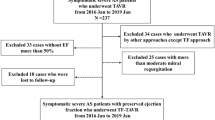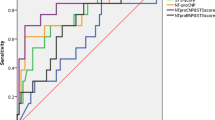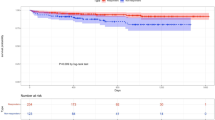Abstract
Background and aim
N-terminal pro-B-type natriuretic peptide (NT-proBNP) has diagnostic and prognostic value in patients with heart failure. The present prospective study was designed to assess whether changes in NT-proBNP levels after surgical mitral valve repair reflect changes in heart failure symptoms and changes in left atrial size, left ventricular size and left ventricular function.
Methods
The study population consisted of 22 patients (mean age: 62.8 ± 14.2 years, 68% male) undergoing surgical mitral valve repair. Serial NT-proBNP measurements, transthoracic echocardiography and New York Heart Association (NYHA) class assessment were performed before and 6 months after surgery.
Results
All patients underwent successful mitral valve repair and no patients died during follow-up. The decrease in NT-proBNP level was associated with the reduction in left atrial dimension (r = 0.72, P < 0.001), left ventricular end-systolic dimension (r = 0.63, P = 0.002), left ventricular end-diastolic dimension (r = 0.46, P = 0.031), and the increase in fractional shortening (r = − 0.63, P = 0.002). Finally, patients with decreasing NT-proBNP levels revealed a significant improvement in heart failure symptoms (NYHA class).
Conclusion
Changes in NT-proBNP after surgical mitral valve repair reflect changes in heart failure symptoms and changes in left atrial and ventricular dimensions and function.
Similar content being viewed by others
References
Levin ER, Gardner DG, Samson WK (1998) Natriuretic peptides. N Engl J Med 339:321–328
Hall C (2004) Essential biochemistry and physiology of (NT-pro)BNP. Eur J Heart Fail 6:257–260
Yoshimura M, Yasue H, Okumura K et al. (1993) Different secretion patterns of atrial natriuretic peptide and brain natriuretic peptide in patients with congestive heart failure. Circulation 87:464–469
Yasue H, Yoshimura M, Sumida H et al. (1994) Localization and mechanism of secretion of B-type natriuretic peptide in comparison with those of A-type natriuretic peptide in normal subjects and patients with heart failure. Circulation 90:195–203
Lainchbury JG, Campbell E, Frampton CM et al. (2003) Brain natriuretic peptide and N-terminal brain natriuretic peptide in the diagnosis of heart failure in patients with acute shortness of breath. J Am Coll Cardiol 42:728–735
Gardner RS, Ozalp F, Murday AJ et al. (2003) N-terminal pro-brain natriuretic peptide. A new gold standard in predicting mortality in patients with advanced heart failure. Eur Heart J 24:1735–1743
Bettencourt P, Azevedo A, Pimenta J et al. (2004) N-terminal-pro-brain natriuretic peptide predicts outcome after hospital discharge in heart failure patients. Circulation 110:2168–2174
Nelson CA, Case C, McCrohon J et al. (2005) Relationship of extent and nature of dysfunctional myocardium to brain natriuretic peptide in patients with ischemic left ventricular dysfunction. Int J Cardiovasc Imaging 21:295–302
Mayer SA, De Lemos JA, Murphy SA et al. (2004) Comparison of B-type natriuretic peptide levels in patients with heart failure with versus without mitral regurgitation. Am J Cardiol 93:1002–1006
Brookes CI, Kemp MW, Hooper J et al. (1997) Plasma brain natriuretic peptide concentrations in patients with chronic mitral regurgitation. J Heart Valve Dis 6:608–612
Sutton TM, Stewart RA, Gerber IL et al. (2003) Plasma natriuretic peptide levels increase with symptoms and severity of mitral regurgitation. J Am Coll Cardiol 41:2280–2287
Thomas JD (1997) How leaky is that mitral valve? Simplified Doppler methods to measure regurgitant orifice area. Circulation 95:548–555
Yeo KT, Wu AH, Apple FS et al. (2003) Multicenter evaluation of the Roche NT-proBNP assay and comparison to the Biosite Triage BNP assay. Clin Chim Acta 338:107–115
Detaint D, Messika-Zeitoun D, Avierinos JF et al. (2005) B-type natriuretic peptide in organic mitral regurgitation: determinants and impact on outcome. Circulation 111:2391–2397
Author information
Authors and Affiliations
Corresponding author
Rights and permissions
About this article
Cite this article
Feringa, H.H.H., Poldermans, D., Klein, P. et al. Plasma natriuretic peptide levels reflect changes in heart failure symptoms, left ventricular size and function after surgical mitral valve repair. Int J Cardiovasc Imaging 23, 159–165 (2007). https://doi.org/10.1007/s10554-006-9138-z
Received:
Accepted:
Published:
Issue Date:
DOI: https://doi.org/10.1007/s10554-006-9138-z




